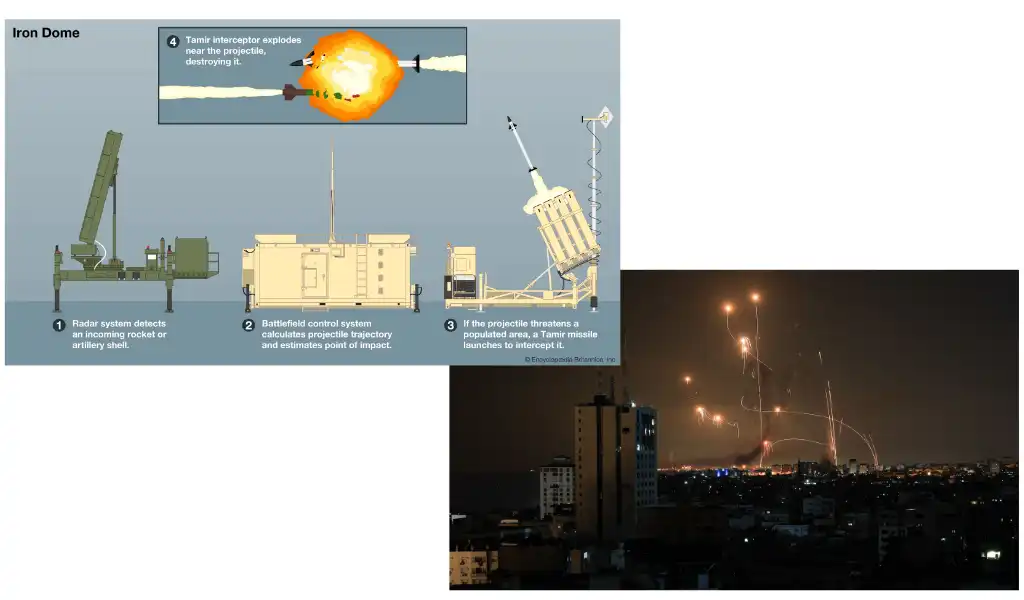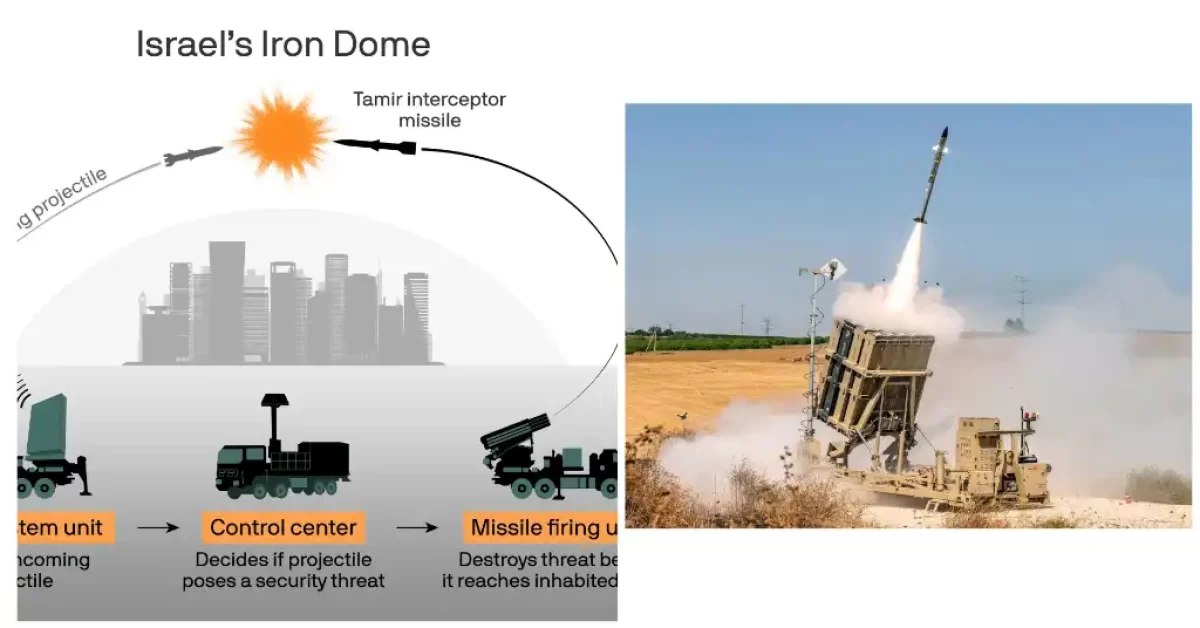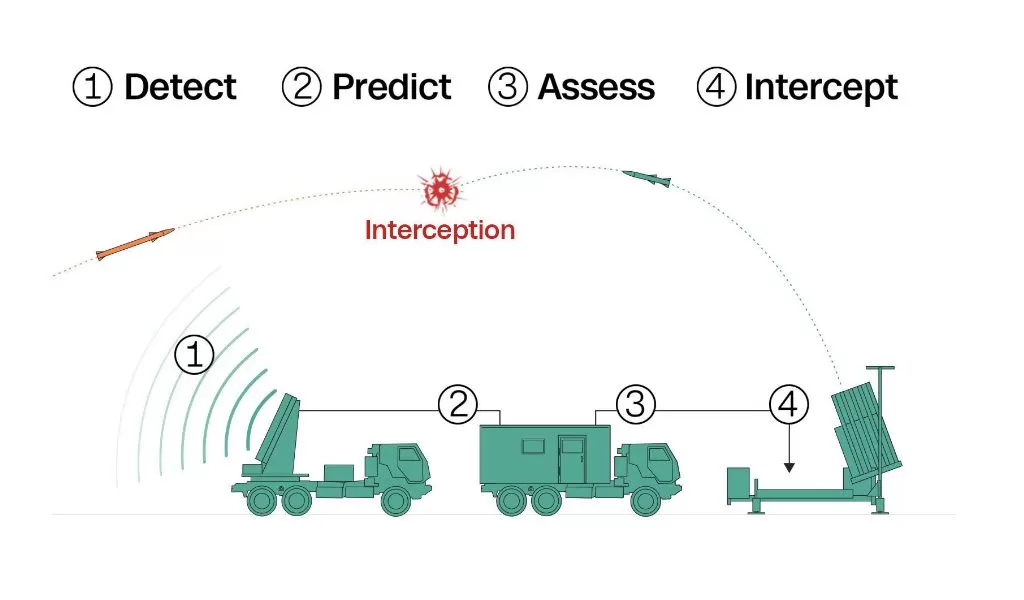We are going straight to the point about this israel iron dome. Rafael Advanced Defense Systems and Israel Aerospace Industries developed this system.
The exercise is to intercept, neutralize, and destroy short-range rockets and artillery shells that are usually fired 4 to 70 kilometers away. Their track will bring them near the Israeli-populated area. In late 2012, Israel stated that the interdiction from Iron Dome’s Intercept Rockets would shortly increase from a maximum of 70 up to 250 kilometers (43-155 mi.).

What is Iron Done?
Iron Dome is a rocket and short-range artillery shielding system built to destroy shells and missiles fired from afar.
Already in 2004, one of the brains behind the creation of the Iron Dome was appointed—Brig. Gen. Daniel Gold has been selected to head the research and development bureau of the Israeli Defense Forces (IDF).
Project leader Colonel S. and his group inside the Administration for the Development of Weapons and Technological Infrastructure (Maf'at) wished for the perfect call for the system.
According to Colonel S., I had changed the first call to ‘Anti-Qassam'; however, while the assignment began to transport ahead, I found out it changed into problematic… I sat down with my wife, and collectively, we had ideas of appropriate names.
She cautioned the name ‘Tamir' (Hebrew acronym for טיל מיירט, Til Meyaret, ‘interceptor missile') for the missile, and for the device itself we idea of ‘Golden Dome.' The following Sunday, ‘Tamir' changed into at once approved. However, there has been a hassle with ‘Golden Dome'—it may be perceived as flashy. It was revamped to ‘Iron Dome'.
In the previous sentence, we indicated that the system is anticipated to break down against short-range rockets and 155 mm artillery shells with a range of up to 70 kilometers. Based on the Company, Iron Dome will carry out undesirable weather conditions both day and night, as will be seen on continuous threat simultaneously.
There are three Iron Dome central components.
As follows this are the three:
- Detection & Tracking Radar
- Battle Management & Weapon Control (BMC)
- Missile Firing Unit
Detection & Tracking Radar:
The radar system is manufactured by Elta, one of many Israeli-based defense companies and a subsidiary of The Israel Aerospace Industries, and by the Israel Defense Forces.
Battle Management & Weapon Control (BMC):
The control center was built for Rafael by Mprest Systems, an Israeli software company. One of the components is the Iron Dome, which is defined as an interceptor missile.
Missile Firing Unit:
The unit launches the Tamir interceptor missile, prepared with electro-optic sensors and numerous guidance fins for excessive maneuverability. Rafael builds the rocket. The battery typically would contain launchers of 3-4 pieces (20 missiles for one launcher).
The system's radar is referred to as EL/M-2084. It detects the rocket's release and tracks its trajectory. The BMC will receive data on the coordinates of the imminent threat through the qualifying alarm. Then, the level of danger is estimated and defined as “threatening the designated area.”
That type of risk would be only known when the arrival rocket impact area has been revealed and the interceptor missile takes off before approaching the predicted point.
Comparison to a typical battery
The primary air defense missile battery usually has an agile radar unit capable of joint mission and tactical ballistic missile defense scenarios, a Missile Launch Control unit, and several garrisons joined in the exact location.
Conversely, the Israel Iron Dome is constructed and installed in a scattered pattern. Each launcher has 20 interceptors; each is deployed and explicitly operated without human interaction via a secured wireless connection. Purportedly, each battery can guard an urban area of about 150 square kilometers (58 sqmi).
Funding
On 9 May 2011, Haaretz posted that the Defense Ministry director widespread Maj. Gen. (res.) Udi Shani said that Israel plans to invest nearly $1 billion in the coming years to develop and produce Iron Dome batteries.
Today, it is no longer a matter of putting up systems with the initial operational capability of shallow penetration but rather the final idea coming up with the entrance allocation of capital and a rough draft of the schedule.” While this is far more than the number currently utilized by the Israeli Defense Forces, the exact number is still up for discussion. We will invest almost $1 billion in what it costs for this. In addition to the $205 million that the U.S. government has authorized, this is the goal,” Shani said.
In 2005, Brig. General Danny Gold decided to set up a program to study and demonstrate an intercepting system. In 2007, the state of Israel began its own technological revolution and commissioned Rafael, one of the leading Israeli, not American (Lockheed Martin), companies to develop ballistic missile defense called Iron Dome.
Israeli corporation mPrest Systems became the installed rate of programming the center of Iron Dome's warfare control system. In less than four years from the start of design, Iron Dome was ready for combat, which, in specialists’ view, is a truly incredible time to create from scratch any weapon system. There was no system like this anywhere in the world in terms of capabilities, speed, and accuracy. We felt like a start-up. — Eyal Ron, a manager at mPrest.
The main developers of Iron Dome clarify that some of the missile components could be available from a toy car (e.g., a Ravens burger or a Toys “R” Us). The reason for the low price and short time interval is the need to use the pieces that are already available.
Testing
July 2008: the Tamir interceptor missile underwent hit testing.
March 2009: Israel was inconclusive without intercepting the absolute rocket to test the missile defense system, but it still performed the tests.
July 2009: the gadget correctly intercepted some rockets mimicking Qassam and a short variety of Katyusha rockets in a Defense Ministry test.
August 2009: The IDF unit was completed, and the soldiers responsible for “the Iron Dome system” were included. The battalion, however, is a component unit of the Israel Air Forces of Air Defending Branch. The first trial will be along the Gaza borders and later along the Lebanon borders. The plan was to have the System technically going on air in June 2010.
January 2010: Using missile barrages closely resembling Qassams and Katyushas, Iron Dome successfully neutralized the threats being targeted at it. According to Defense Ministry Director-General Pinhas Buchris, after some days of the system's operation, it is going to fully “reshape” security for both the residents of southern and northern Israel.
July 2010: The device efficiently intercepted a couple of rocket barrages mimicking Qassams and Katyushas. The test demonstrated the system’s ability to differentiate rocket launches that were threats from those not aimed in the designated areas and, thereby, did not require any interceptions.
March 2011: The Israeli military brought the Iron Dome to operational status while Defense Minister Ehud Barak dictated the deployment process.
Which country has the Iron Dome?
The Israeli Iron Dome missile defense system was successfully integrated into their defense system. It is intended to knock down in the mid-range war in which weapons such as short-range rockets and artillery shells fly from 4 kilometers (2.5 miles) to 70 kilometers (43 miles) apart.
This innovative system, brought to life by Israel's defense industries—Rafael Advanced Defense Systems and Israel Aerospace Industries—has benefited from the initial investment and support of the Israeli government and the U.S.
The successful deployment of the Iron Dome for years now has indeed helped the state of Israel minimize the damage that would otherwise be inflicted on the Russian citizens.
Can Iron Dome stop cruise missiles?
The Iron Dome system would down and destroy short-range rockets, artillery shells, and mortar rounds that usually successfully fly in target areas, not cruise missiles.
It has already been proven to be effective in addressing the threats, but the challenge of intercepting a cruise missile lies in the fact that these missiles are faster, fly higher into the air, and turn sharply compared to normal rocket threats.
Cruise missiles operate at low altitudes and can flutter their speed and lines of flight, a feature uncommon in ballistic threats, thus rendering them more difficult to detect and intercept.
Furthermore, the advanced guidance system and the stealth characteristics are another cause to pass unnoticed by the air defense systems.
The Iron Dome system is not specifically designed to defend against cruise missiles, but it may be possible to develop changes or upgrades that target its multi-threat capability. However, as of my last update in January 2022, the primary focus of the Iron Dome system remains on countering short-range rocket and artillery threats.
Which is better, Patriot or Israel Iron Dome?
Patriot Missile Defense System:
- Range and Altitude:The Patriot radar is meant to intercept short- and long-range ballistic missiles, cruise missiles, and aircraft; therefore, its elevation angles are higher, and the range is longer than that of the Iron Dome. It can engage a target at a range of up to 100 miles and an altitude of up to 15 miles.
- Multi-Layered Defense:The Patriot missile system brings multiple strike capacities into play, involving long-range, medium-range, and short-range interceptors, thus allowing for a broader scope of threat management.
- Operational Experience:For nearly two decades already, Patriot systems have been in service with many different countries as it has already received its battle proof in the context of the Gulf War, theIraq War, and recent conflicts in the Middle East.
- Interoperability:The Patriot is used redundantly by NATO members and other allies to prepare for and fulfill the joint operation.
Iron Dome Missile Defense System:
- Short-Range Defense:The Iron Dome system is designed to intercept short-range rockets such as Katyusha rockets, artillery shells, and mortar rounds, the range of which does not exceed 70 kilometers (43 miles).
- High Success Rate:The Iron Dome proved to be unquestionably capable of intercepting and exploding incoming threats, and it was most evident during the Israeli-Gaza conflicts.
- Low-Cost Interceptors:Iron Dome interceptors are moderately budgetary. The advantage is that the defense is more cost-effective than other missile systems, which are overly extravagant for the missile danger.
- Mobile and Flexible Deployment:The Iron Dome system is mobile and capable of deployment without delay to defend against threats on any part of the frontline, flexibly extending coverage as necessary.
Who has the best missile defense system?
Not a perfect defense system exists, but Israel's system encompasses an overall enhancement among the best missile defense systems.
Here is why:
Multi-layered defense:They display system combinations that can detect missiles from different distances and altitudes with other radars. This is one of the most famous and fully developed air defense systems that targets short-range rockets and artillery shells. They also have Arrow missiles for ballistic missiles.
Proven track record:This Iron Dome, especially, will typically have a 90 percent chance of being a success in practical use.
It is also worth mentioning that missile defense systems and other countries are actively pursuing advanced weaponry systems capabilities.
Who builds missiles for the Iron Dome?
These industries always brought their intellect, which was difficult to be compatible with in some circumstances but lies underneath the idea of a joint understanding of how the anti-missile systems work.
The missiles for the Iron Dome system are primarily developed and manufactured by two Israeli defense companies: Spark GmbH, Advance Defense System of Israel, and Israel Aerospace Industries.
The main actor in the Iron Dome program is Rafael Advanced Defense Systems, which represents the whole project's work, from integration to development to production of interceptor missiles.
Rafael is an Israeli defense technology company that is at the forefront of missile defense systems. It is also engaged in precision-guided weaponry and other latest defense technologies.
Israel Aerospace Industries (IAI) also plays a big hand in the not-alone research of the development and manufacture of the components for the Iron Dome system, such as theinterceptor missile. IAI is one of Israel’s largest aerospace and defense entities, and it is widely known as an expert in ballistic systems, satellites, and drones.
Rafael and IAI have focused particularly on shaping the Iron Dome system's capabilities as needed by the Israeli Ministry of Defense and governmental agencies in response to continuously changing threats and operational requirements.
The partnership between these two organizations has been a defining factor in realizing the Iron Dome, which reduces geographical tensions during conflicts and security breaches.
Can the Iron Dome protect against drones?
One of the best features of the Iron Dome system is that it can destroy short-range rockets, artillery, and mortar shells, which are currently used.
Although the system may be capable of involving specific types of drones, its main focus and efficacy are directed against certain types of drones for which it was shaped.
Drones pose different challenges compared to traditional rocket threats. They can move below the altitude to which radars and weapons like the Iron Dome are set, speed up or slow down, and have tiny signatures; this makes these UAVs harder to detect and possible to intercept with systems like the Iron Dome that were optimized for larger and slower-moving airborne objects.
That said, Israel has developed and deployed other defense systems specifically tailored to counter drone threats, such as the “Drone Dome” system developed by Rafael Advanced Defense Systems.
The Drone Dome system incorporates radar, electro-optical sensors, and electronic warfare capabilities to detect, track, and neutralize hostile drones, including small UAVs (Unmanned Aerial Vehicles) used for reconnaissance or attack purposes.


